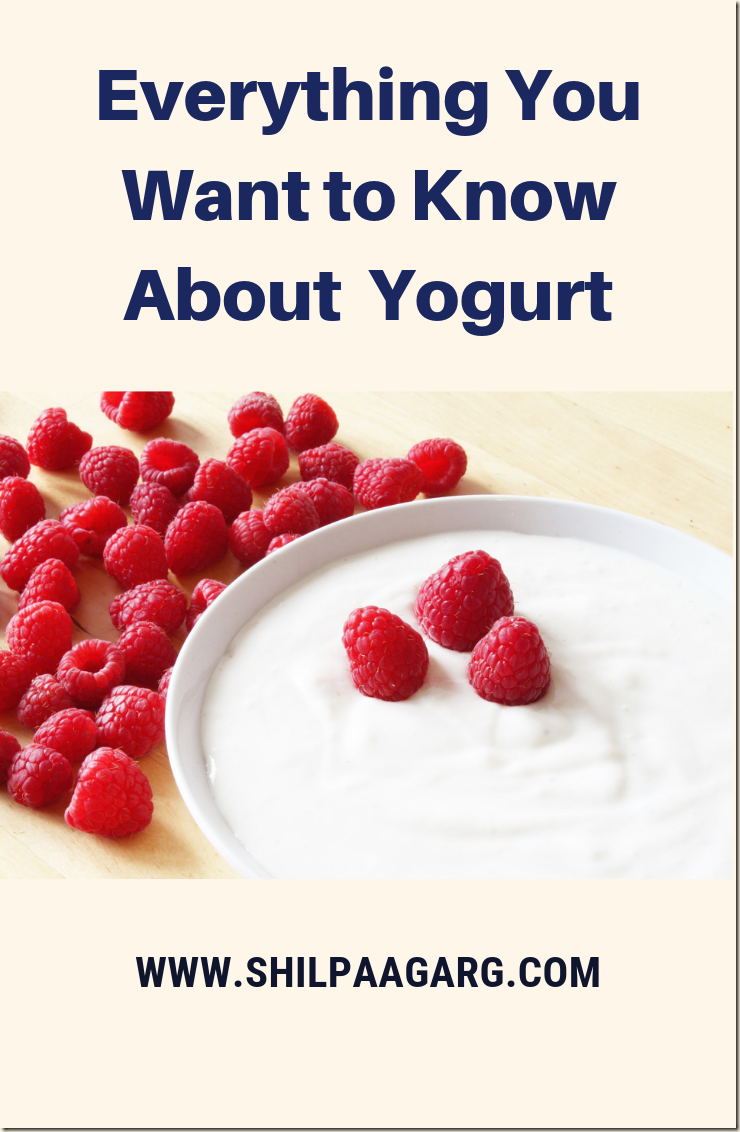The yogurt shelves in the super market look totally different from what it was a few years ago. The market is flooded with newer flavours and brands of yogurt.
If you flip through any wellness magazine, you will be advised to eat yogurt everyday.
Facts about Yogurt
- Yogurt is made by fermenting milk with a yogurt culture.
- Health benefits of yogurt include bone health and aiding in digestion.
- Some yogurts contain active, living bacteria known as probiotics, which can help keep the intestines healthy and restore balance in of intestinal flora.
- Yogurt is loaded with protein, calcium, and vitamin B6 and B12, riboflavin, potassium, and magnesium.
Difference between Yogurt and Curd
Curd and Yogurt are almost the same thing, mainly differing in the method of preparation.
Indian curd made by boiling and cooling the milk to 30-40°C and adding a spoonful of curd. Curd has lactic acid bacteria or lactobacillus. This bacteria multiplies itself and in few hours ferments the milk to form curd.
Yogurt is prepared using similar techniques to curd but the fermentation of the milk is done by adding two specific strains of bacteria called lactobacillus bulgaris and streptococcus thermophilus. Other strains of lactic acid bacteria may also be added. The addition of these bacteria makes the product standardised and homogenous. This ensures both quality and right quantity of bacteria in the yogurt.
Types of Yogurt
Here are different types of yogurt.
Low Fat or Non-Fat : Low-fat, or reduced-fat yogurt, is made with 2-percent milk. Non-fat yogurt is made with zero percent or skim milk.
Greek Yogurt :Greek yogurt is thick and creamy. It is made by straining regular yogurt to remove the liquid whey. It is often used in Mediterranean-style cooking and dips. It has a higher protein content than other yogurts, but it contains less calcium. It is available in full fat, reduced or low fat and non-fat or zero percent.
Balkan-style or Set-style Yogurt :The warm cultured milk mixture is poured into containers then incubated without any further stirring. This has a characteristic thick texture and is excellent for enjoying plain or using in recipes.
Swiss-style or Stirred Yogurt : The warm cultured milk mixture is incubated in a container, cooled and then stirred for a creamy texture, often with fruit or other flavourings added. This yogurt is often slightly thinner than Balkan-style or set yogurt and can be eaten as-is, in cold beverages or incorporated into desserts.
Skyr : Similar to Greek yogurt, skyr, pronounced “skeer,” is an Icelandic-style yogurt that is dense, creamy and high in protein. Compared to regular yogurt, skyr requires 4 times the amount of milk to make and contains 2 to 3 times more protein.
Kefir :Kefir is a cultured, fermented milk drink, originally from the mountainous region that divides Asia and Europe. It is similar to yogurt – but a drink, with a tart, sour taste and a slight ‘fizz’. It contains three times the amount of probiotic cultures than yogurt.
Lassi: This Indian yogurt drink is made by thinning yogurt with a little water and adding either savory spices such as cumin, or sweet fruit juices such as mangoes.
Matsoni : It is a fermented milk product of Armenian origin, found in Caucasian cuisine, particularly in Armenia and Georgia. In Japan, it is called Caspian Sea yogurt. This yogurt is set at room temperature and requires a longer period of fermentation.
Frozen Yogurt :Frozen yogurts are often seen as a healthful alternative to ice cream. However, many frozen yogurts contain the same amount of sugar or more as regular ice cream.
Flavored or Fruity Yogurt : It’s the sweet, cool, flavoured and “healthy” version of yogurt. Fresh or cut fruits like strawberries, banana, mango etc are added to yogurt along with sweeteners.
Labneh : This Middle-Eastern yogurt is uber-creamy. It is extensively straining which makes it thicker than even Greek yogurt. It’s generally made from cow’s milk and is often drizzled with some olive oil, topped with a sprinkling of za’atar, and served with flatbreads for dipping.
Non-dairy yogurt : Non-dairy yogurt alternatives include soy yogurt and coconut milk yogurt.
Lactose- free Yogurt : Lactose-free yogurt is made with cow’s milk, but has been treated to break down the lactose or milk sugar found in milk. It tastes very similar to regular yogurt and is a good source of protein, calcium and probiotics.
Diet Tips
Yogurt is healthy and nutritious and should be a part of regular diet. Here are some ways to incorporate it in daily diet.
- Have plain, unsweetened yogurt and sweeten it with fruit, unsweetened applesauce or a small amount of pure maple syrup or honey or add vegetables like cucumber, tomatoes, boiled potatoes, mint etc to make raita.
- Avoid pre-made fruit and yogurt desserts, as these often contain unnecessary added sugars.
- When baking, use yogurt instead of butter or oil.
- Use plain Greek yogurt instead of sour cream to top baked potatoes or tacos.
There are a lot of reasons to have yogurt, it’s delicious, versatile and loaded with nutrients.
Do you enjoy yogurt? Which type do you like best?
My theme for this year’s Blogging from A to Z April Challenge is Food Talks. Join me for some interesting, fun conversations about food experiences, experiments, basics, tips, ideas, hacks, trends and much more.


I love yogurt. Delish and healthy.
I’m eating a cup of plain, homemade yoghurt as I read this post. I prefer creamy plain yoghurt to sweetened, low-fat varieties from the store. Some mornings I put in a banana, apple and grapes in my yoghurt to eat for breakfast or dessert. These fruit are easy to get for me. In summer, I may also add a peach or strawberries to the yoghurt. This dish also makes a very nice dessert for me.
Yoghhurt is very easy for me to make. I have use my leftover yoghurt to make a new batch with full cream milk, bottle it and then store it in the fridge with other groceries. It’s nice to always have it at hand to snack on, or even use to make raita and tzatziki. Sometimes I even use it to bake bread.
This is a rather informative post on yogurts. I never knew that yogurt and curd are different. Great post.
It is the best snack to have. I love it!
The supermarket is flooded with all yoghurt of all flavours. I prefer the simple Indian curd. I prepare raita, curd parathas and curd-rice. Dahi wada is another yummy dish. Learnt about different types of yogurt today.
https://ideasolsi65.blogspot.com/2019/04/yolk-sac-parts-of-body.html?m=1
Loved the post. Good information on yogurt. But my first preference is Indian curd while my younger sister prefers yogurt
an informative post! loved it
I love Yogurt shilpa:) David is good in setting it with milk and its very delicious – sometimes I will add cucumber, pomegranate and grapes and if there’s apple I will add that too and enjoy like a desert. I am impressed by your post and learnt so many types of Yogurt. today, thank you for sharing.
yogurt a gut-friendly probiotic food
I’ve never heard of quite a few of these yogurt types. Thank you for the introduction and explanation of each item. Very helpful!
I LOVE yoghurt! And, from the list you mentioned here, I would love to sample each and every–except of course, the lassi and the curd which is a staple food. 🙂
Excellent post with very relevant info.
The first time i had yoghurt was on a jet airways flight ha ha ….and it was love at first sight 😀
Informative post. I’ve sometimes thought if the two were different but never bothered to learn. Your series is a served plate to us
I love experimenting with raithas and spreads. Great information here, Shilpa.
Nice information .
I like Kefir very much. I also serve kefir on a regular basis for my family. Thanks for the share shilpa ji.
It’s Greek yoghurt for me, I never go a day without it either on its own or with a dribble of honey.
My final Children’s Story – for now!
As I said above, i love yogurt, and it is a part of my everyday diet. I begin my day with yogurt and banana smoothie, sometimes have curd rice and sometimes lassi/buttermilk. I prefer it over milk and it is also the main ingredient in my skincare regimen.
Definitely love yogurt — at least one shelf in our fridge is reserved for it. I use it in a lot of recipes. I remember the first time I used yogurt as a substitute for baking with oil/butter and was amazed at the result. Supermarket flavored yogurt is full of added sugar and salt and avoidable, Also, can’t always rely on the consistency. We love our homemade, although we also occasionally buy the packaged plain version. Great info, Shilpa! Had not heard of some of the types of yogurt.
Wow, I actually didn’t realize just how many different kinds of yogurt there were. I love cooking with Greek yogurt a lot and I love mango lassies! They’re actually one of my favorite drinks. Anything with mango really is my favorite drink LOL. Thank you for the abundance of information on all of these types of yogurts!
I’m such a clueless person, yogurt & curd has been the main part of my diet for ages and all I thought was different in both was just the consistency. geee… thanks for sharing the details about them now at least I know the difference. much appreciated post.
I didn’t know that yoghurt and curd were different. I thought the names could be used interchangeably. Funny thing is no one here have heard of curd. It took a while for me to call it yogurt. I mostly buy Greek yoghurt. I love how creamy it is and is great for making fruit salad or raita.